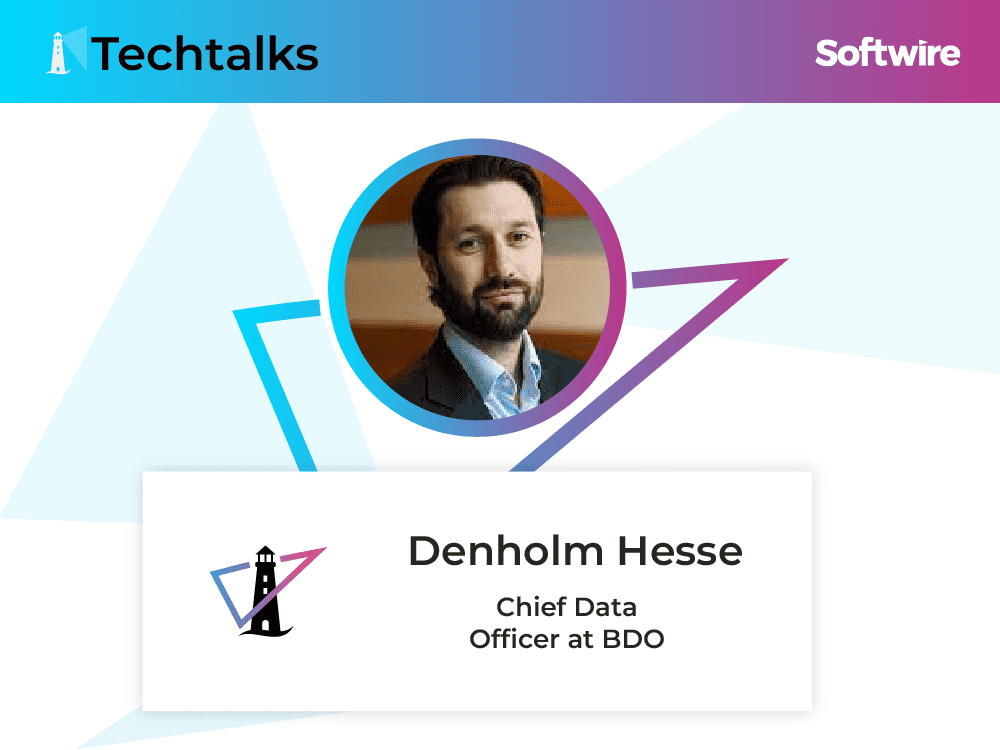Leadership plays an important role in communicating a vision that encourages taking risks and making it safe enough to take risks.
Monal Sangvhi, Technology Leader
Regulation and compliance can feel like quicksand when it comes to delivering innovative products and solutions.
Better be safe than sorry has long been the mantra. The status quo may be slow – but it’s safe. Familiar.
But it doesn’t have to be that way. Nor, really, should it be.
As our latest guest Monal Sanghvi explains—a seasoned technology leader with over a decade of experience in investment banking—CTOs and other tech leaders in highly-regulated industries can have their cake and eat it.
In this episode, Monal explains how:
- The importance of encouraging risk
- Giving teams the freedom to embrace innovation initiatives
- How agility doesn’t mean fragility
- Practical approaches to organising your teams
Check out the illuminating discussion below:
About our guest

Monal Sanghvi
Technology Leader
Monal is a technology leader with over a decade of experience in investment banking technology. Most recently, she has led high-performing, cross-functional teams at Tray.ai, a modern integration platform as a service (iPaaS), and Zoa.io, a green energy tech SaaS. She enjoys working collaboratively at the intersection of engineering, product, design, data, and business. Monal believes in the power of coaching and mentoring to empower her teams to do their best work.
Transcript
Zoe Cunningham: Hello and welcome to the Digital Lighthouse. I’m Zoe Cunningham. On the Digital Lighthouse, we get inspiration from tech leaders to help us to shine a light through turbulent times.
We believe that if you have a lighthouse, you can harness the power of the storm. This week, we are very happy to welcome Monal Sanghvi to the show.
Monal wears many hats. She’s a strategic technology leader, a coach, a product engineer, and most recently, the senior engineering manager for consumer apps at Zoho, a business powering the energy transition through brilliant consumer experiences. That gives us plenty to talk about.
Welcome to the podcast, Monal. Throughout your career, you’ve had a big focus on culture. Energy is obviously a unique industry to work in, being both fast-paced but also highly regulated.
Of course, that can make it a little bit rigid. Given those conditions, how have you inspired a culture that actively embraces innovation?
Monal Sanghvi: Yeah, I think throughout my career as well, going back to the days when I started in financial services, my focus has been on creating and influencing culture that embraces innovation. I’ve often been part of product development initiatives that require fast-paced delivery, but at the same time, there are constraints.
Putting those constraints in place to make sure that you’re compliant with regulations or the apps are secure enough for the environment you’re in. I think that leadership plays a very important part in the culture and how leaders communicate their vision. It comes down to how they encourage taking risks and making it safe enough to take risks.
This involves mentoring employees and also participating in innovation initiatives that might be part of either the regular product development cycle or outside of it. At the end of the day, I think it is about user-centric innovation and focusing on user needs to drive that innovation, whether the user could be your customer, if it’s a B2B. It could be the consumer, if it’s a B2C.
Or it could be just the internal users or developer teams that are building a developer platform, for example. It requires responding to what the current needs are, but also anticipating future challenges and opportunities. Leveraging analytics and feedback to guide those innovation results.
I think that for highly constrained environments, such as energy or being in finance, it helps to think ahead and plan a strategy that is a month long, a quarter long, six months long, and so on and so forth. Something that inspires action from everyone in the organization and is focused on what problem we are solving and who we are solving it for. I think that’s essentially what I think the role of leadership is in influencing culture.
I think agile methodologies can be adapted to different types of environments to encourage rapid development and iteration. It could mean that you implement certain sprints that are focused on compliance innovations, for that matter, or innovations that are perhaps in spaces that are very rigid. And those could be done in parallel alongside existing book of work or could then be embedded in the book of work after getting the buy-in from senior management or leadership.
Zoe Cunningham: Yeah interesting. I was actually about to ask a question that I think you’ve just answered because I can see that as a leader, you have to deliver both on how are we compliant and how are we secure, and you have to deliver on what is our new product, where is our product innovation coming from, how are we competitive.
If you’re the engineering leader, you have to deliver both of those things and you can’t choose one or the other. But I can see that you then have a choice of how you flow that down to your team. Do you flow one part down to one part of your team? Do you say you are the innovation people and you are the security people or do you try and blend it?
Monal Sanghvi: Yeah, I think that most often I have ended up keeping that separate. So having a core team that still is very diverse and factors and perspectives from a distributed team across the globe can be very helpful sometimes and that team that focuses on it, I would also recommend rotating within the larger group who works on those innovation initiatives if they are done separately from the regular delivery cycles. I think you can also embed innovation inside your regular delivery cycles and that can be done via leaning on any existing structures that the organization might have around it.
So encouraging teams to be part of company-wide hackathons or being part of some innovation days or learning time days can be very helpful and sometimes those initiatives that have come out of those specific days become part of the actual product because they are actually solving a problem.
So again, when those ways of working around keeping the user front and center of the solution is also how these innovation days are spent or hackathon days are spent, it can really bring back the focus on solving a real problem for the users and then the product evolves as those innovative ideas are factored into the product itself.
Zoe Cunningham: And just quickly, does that then create a kind of gated scenario where you’ve got innovation but then you have to almost go through a process of checking how do you make it compliant and how do you make it secure?
Monal Sanghvi: Yes, I think creating a template for what is required to deploy your software can be really helpful. That can essentially focus on a series of steps that need to be completed before the software is considered production ready or it can be automated as well. So yeah, with essentially the goal of automating those bits, you can start improving how frequently you deploy those innovations as well inside the product. So I think it depends on how mature your software delivery already is and where you would want to put in effort.
Sometimes those innovation efforts can also be focused on how to make things efficient in your software delivery. Let’s look at how to make our CIs and ECD pipelines be able to deploy on demand or deploy within the same day. It can be done even in highly regulated environments if you have a checklist of things that need to happen, what kind of testing needs to be done before we are confident that we can deploy the software.
And sometimes it’s about making sure we also can roll back very easily and we can automate that if need be. And we can put it against some feature flags so that if it is something that is an experiment that does not resonate with the users, we can also just turn it off without having to impact any of our day-to-day.
Zoe Cunningham: Yeah, exactly. And we just started talking about Agile, so I’d love to hear if you’ve got thoughts on balancing the more formal aspects of Agile, you know, kind of big A Agile versus small A Agile, balancing the kind of formal methodology with the kind of need for agility when developing a product. And does that shift depending on different teams?
Monal Sanghvi: I think it does definitely shift based on the maturity of the people within the team and how long they have been working together. And it also shifts based on what type of project you’re working on and what type of product you’re building, right? So it really depends.
I think there are two practical approaches that I’ve seen be implemented in my experience that have worked well, which really are what I would say is a fluid Agile approach and a hybrid Agile approach. Very similar to, I think, what you say, Agile with a capital A or Agile with a small A, right? I think it depends on how adaptable the team is and what the focus is on delivery. So based on that, you can choose.
Now, what I mean by fluid is taking the parts of Agile that have worked and implementing those and describing what hasn’t worked, right? So it could be following Scrum in two-week sprints, but not having all the typical rules such as Scrum Master and Product Owner in the team. So that’s one option. And then some methodologies like Scrum Band, which offer the best of both Scrum Band and Band, are also what I would say fall under fluid approaches.
And then a hybrid approach could be running some projects through a traditional waterfall model because that is best suited for the nature of the problem, right? Where all the requirements are fixed, they are known and clear. For example, rolling out a security program.
Zoe Cunningham: I was going to say, for example, you have two clients, right? You know what you have to achieve.
Monal Sangvhi: Yeah. There are two types of agilities in my view. Agility in the execution of the software development lifecycle and how we deliver the product.
And then there’s also business process agility. So making sure that if there are business processes that can be made more efficient by following agile or lean practices, then that is a part of the business that can focus on improving their ability to act fast on changes coming in from external factors such as regulations or compliance or legal, what have you. And I think that can also make product development very efficient because the problems you’re solving for are made agile at the business process level rather than having to be something that the software needs to solve for the users.
And this is because my experience is in building an internal work management platform. So that is where I’ve also seen concepts such as Lean UX being adopted by the business and those having nothing to do with the software as such, but just how they work themselves within the operations group of the business.
Zoe Cunningham: Yeah, it’s a really interesting way to think about it because I think that for most people in like a CTO role, the business processes are almost like outside of your team. So it becomes a kind of, well, it would be great if they were more agile, but it’s not within my control. Have you got any suggestions for particularly positive ways that CTOs can kind of influence outwards?
Monal Sanghvi: Frequent collaboration and early collaboration in understanding the problem statements is very helpful in that case. So oftentimes as someone who’s in that CTO role, if you can ask questions that help you understand the needs of the customers better, that can lead to some explorations that help the business understand what they could be doing better as well.
So always suggest some improvements as well as you find out what is it that you want to solve for. And then also having continuous feedback. Once you have a product out there or an MVP, you can iterate on it.
So early collaboration and continuous collaboration is very helpful with the business in helping develop relationships where you can start influencing these type of conversations.
Zoe Cunningham: Yeah, I like your idea of asking questions so that ideally you ask the question and they give you the answer that you were wanting to say to start with.
Monal Sanghvi: Yes, it’s hard to do, but can be. I think it’s a very helpful one.
Zoe Cunningham: Well, on collaboration, could you maybe give us some more detail on how strategic collaboration and alignment with the company’s mission can expedite product development processes?
Monal Sanghvi: Yeah, absolutely. I think leaning on a company’s mission to make sure everyone is moving in the same direction and leveraging their strengths towards that common goal is where it is helpful to make sure there’s an alignment, right? And that’s where the strategic aspect of collaboration comes in, right? You want to make sure that everyone who is working on developing the product has a clear understanding of the mission and it is tied to a larger company mission at the same time as having a team-specific mission or a group-specific mission.
So it cascades down in a way from the company to the product development team, in my view, and it can also make sure that different departments within the company are also aligned and are not solving the same problem in two different parts of the organization. So what I mean by that is that making sure that there is cross-departmental synergy is facilitated by having an alignment with the company’s mission. So as an example of that, one of the initiatives that I’ve worked on required front-to-back integration of the business, and this was a company mission that the technologists and the firms were focusing on because it came from the company to us.
And I had to work across the divisions. I was the back office, middle and back office part of the business, and then I had to work with the front offices or the department to understand is there a common problem that we can solve for, and then can we collaborate and deliver on something that adds value to both the businesses but is solved in one place rather than having to duplicate the efforts within the two departments.
So I think that makes it easy as well.It gives you an opportunity to reflect on what is the mission and vision for your team and how does it align with the broader company goals. A lot of that can lead to some synergies you may have not instantly thought of when you started developing your solution in isolation.
Zoe Cunningham: Yeah, and can really speed up process for everyone then, right?
Monal Sanghvi:Yeah, exactly. It also just brings in diverse perspectives from different departments as well. When you align to a company mission because it can lead to a more holistic approach which considers all aspects of the product and what other business functions it touches because often times if you work on building something that you think you understand, you just working closely with complex organizations at least, working closely on understanding the end-to-end business process can lead to more perspectives which can lead to more ideas for innovation because there might be inefficiencies in those steps when you look at the full picture.
So you just have to look at the bigger picture, I think, and whether your goals are aligned to that or not. And I think even coming back to Agile, it helps the teams. If you have the right Agile practices in place, it helps teams quickly adapt and realign to the company’s mission as the market and mission evolves as well. So having those methods in place already successfully implemented in your teams can make sure that if the company strategy pivots, your teams can follow on from there.
Zoe Cunningham: Yeah, I think that’s right. And I think it’s so interesting when you’re looking at technology development, how it does all link in together. So I think that, as you say, once you understand how Agile development works, it links in with everything else. And also back to rights, as you were saying at the start of the podcast, innovation comes from doing something new and exploring new areas.
I just wanted to finish up by asking, you know, talking so much about evolution and everything’s evolving so rapidly and it seems to get faster and faster and faster. Have you got any guiding principles or experiences that you’ve relied on to navigate new challenges in product development and also in leadership roles?
Monal Sanghvi: Yeah, I think embracing a mindset of continuous learning and curiosity has been extremely valuable in keeping up with the evolving tech landscape. In order to keep up with the trends, it requires a blend of adaptability and foresight and a solid leadership foundation.
So if you can adapt to trends because you had foreseen them or you are noticing them while working on your existing product development, you can start to map out a path to keep your product up to date with what’s latest and greatest in the industry.
I was working with technologies like Tableau to show data visualizations and they did not have an API until a point and then they released one which was making it easy to access that data through some JavaScript APIs. And that meant that easier integration was possible and rigiditizing those components from Tableau and embedding them in the platform was easier. And we could adapt to that as quickly as we could because we were making sure that we are aware of the progress within that product itself. So that’s an example of what I was trying to say.
Yeah, I think making sure that your teams are flexible to adapt to those new trends means you give them the space to try different things as well. So sometimes I call this doing the boring work as the leader. That means doing some of the administrative work or the operational work that lets your teams focus on innovation can also be helpful because you then have a team that is able to stay ahead of the trends and is able to work on new technology at the time when it’s released or close to that and they can experiment to be early adopters of that technology because the work that needs to be done in order to keep existing solutions up and running is something that they see the leadership team also contributing towards.
So I think that’s another way in which I think you can keep up with the landscape by having a very strong team who wants to do that and they embrace that mindset as well as they go on and create future leaders in them who would take on such type of roles.
Zoe Cunningham: Yeah, and as you were saying about having a culture of flexibility and learning and change and that’s what ties everything together.
Monal Sangvhi: Yeah, change as a constant mindset is what I would say is a value that I hold dear to my heart because that is the world we live in and being able to adapt to those skills and experiences as you go can help.
Zoe Cunningham: Thank you so much, Monal, for coming on and helping us to shine a light for others. I think change is a constant that’s going to be my mantra for the rest of the year.
Monal Sangvhi: Thank you.



